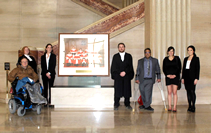Act Now

Empower U: Learn to Access Your Disability Rights Training on Canadian Human Rights, the Convention on the Rights of Persons with Disabilities (CRPD) and its Optional Protocol (OP) training aims to increase awareness of how to address discrimination using more familiar Canadian human rights laws such as Human Rights Codes and the newer international Convention on the Rights of Persons with Disabilities (CRPD). This is training for persons with disabilities by persons with disabilities. The training is part of a project funded by Employment and Social Development Canada and implemented by the Council of Canadians with Disabilities (CCD) in collaboration with Canadian Multicultural Disability Centre Inc. (CMDCI), Citizens With Disabilities – Ontario (CWDO), Manitoba League of Persons with Disabilities (MLPD) and National Educational Association of Disabled Students (NEADS). Read more.
Sign Up for our monthly digest
A monthly newsletter from CCD about what is happening in the community
Constitutional Equality Rights: People with Disabilities Still Celebrating 30 Years Later
Related Documents
April 17, 2024
Council of Canadians with Disabilities : 48 years strong and "On The Road to 50 Years"
March 21, 2024
Everyone has a responsibility to end racism
December 10, 2023
International Day of Human Rights
For immediate Release
April 17, 2012
April 17, 1982 signalled a new era beginning for Canadians with disabilities, as Canada’s new Constitution came into force. In the Charter of Rights and Freedoms, Canada made a constitutional commitment in Section 15 to equality before and under the law for those living with disabilities. (Section 15 came into force in 1985.) Canada’s constitution was the first to include equality rights protection of people with disabilities.
Canadians with disabilities, including Yvonne Peters and Jim Derksen, went to Ottawa to convince the Trudeau government to include people with disabilities in the Charter’s Section 15, Equality Rights. The original draft of Section 15 omitted people with disabilities. Canadians with disabilities believed inclusion in the Charter of Rights and Freedoms had both symbolic and legal value. Looking back on the work of 30 years ago Peters states, “Clearly, our efforts helped to achieve a significant legal victory, which marked a new social consciousness of disability rights. I am deeply honoured to have had the opportunity to play a small role in this important victory.”
In 1981, when the Charter was being negotiated, disability was viewed more as a medical issue than a human rights or legal issue. However, through the Council of Canadians with Disabilities (CCD), a national group working for an inclusive and accessible Canada, people with disabilities were forging new approaches to disability. With the inclusion of disability in the Constitution, people with disabilities created a new arena, constitutional law, where they could influence how Canadian governments treated people with disabilities.
CCD is playing an important role in advancing Canadian jurisprudence on equality rights. CCD intervened in the Andrews case, the first Section 15 case heard by the Supreme Court of Canada. With the Andrews case, CCD began to explain to the Court how Section 15 supports a vision of substantive equality which overcomes unintended, as well as intended, barriers.
When VIA Rail attempted to put inaccessible passenger rail cars into service, CCD, through the Transportation Committee chaired by Pat Danforth, challenged VIA’s actions through the court and won a victory for all Canadians needing accessible transportation, thanks to the protection afforded in the Charter of Rights and Freedoms. Danforth was at the Supreme Court on March 23, 2007, when the Court, in the VIA Rail decision, said an emphatic NO! to new barriers.
Last month in the Moore case, CCD shared its perspective with the Supreme Court about how to effectively accommodate students with disabilities in the public school system.
The inclusion of disability in the Charter has an effect beyond the courtroom. When Vangelis Nikias approached the Bank of Canada about making accessible currency, the Bank was open to adding tactile cues to Canada’s money to make it more usable by people with vision impairments; because they knew that Section 15 of the Charter compelled them to address the barrier created by inaccessible money. “The Canadian accessible currency represents a tangible example of changing our environment to make it more accessible and more inclusive for all, regardless of how they recognize and handle paper money,” states Vangelis Nikias, CCD’s CRPD Project Manager.
“CCD celebrates the anniversary of the Charter and all those who have been using it to remove barriers to the full and equal participation of people with disabilities,” states Tony Dolan, CCD Chairperson. “April 17 is an important anniversary which we must celebrate every year.”
-30-
For more information contact:
Yvonne Peters, CCD Human Rights Consultant – 204-832-0681 (w)
Jim Derksen, CCD Human Rights Committee Member – 204-786-7937 (h)
Pat Danforth, Chairperson CCD Transportation Committee – 250-383-4443 (h)
Vangelis Nikias, CRPD Project Manager – 613-240-5730 (cell)
Laurie Beachell, National Coordinator – 204-947-0303

Some members of the CCD team at the Supreme Court of Canada on April 25, 2018 to intervene in S.A. v. Metro Vancouver Housing Corporation. (L. to R. Bob Brown, CCD Human Rights Committee member, Dianne Wintermute, legal counsel (ARCH), Dahlia James, a second year JD candidate at U. of Ottawa and Prof. Ravi Malhotra’s Research Assistant and Luke Reid, legal counsel (ARCH) , and Prof. Ravi Malhotra, a member of the Human Rights Committee, Prof. Anne Levesque, Chair of the Human Rights Committee, and Erin Carr, a second year JD candidate.
The Latimer Case
The Latimer case directly concerned the rights of persons with disabilities. Mr. Latimer's view was that a parent has the right to kill a child with a disability if that parent decides the child's quality of life no longer warrants its continuation. CCD explained to the court and to the public how that view threatens the lives of people with disabilities and is deeply offensive to fundamental constitutional values. Learn more.
